
Asturias, officially the Principality of Asturias, is an autonomous community in northwest Spain.

Gijón or Xixón is a city and municipality in north-western Spain. It is the largest city and municipality by population in the autonomous community of Asturias. It is located on the coast of the Cantabrian Sea in the Bay of Biscay, in the central-northern part of Asturias; it is approximately 24 km (15 mi) north-east of Oviedo, the capital of Asturias, and 26 km (16 mi) from Avilés. With a population of 271,780, Gijón is the 15th largest city in Spain.
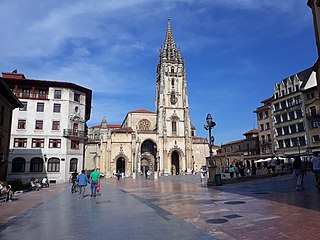
Oviedo is the capital city of the Principality of Asturias in northern Spain and the administrative and commercial centre of the region. It is also the name of the municipality that contains the city. Oviedo is located approximately 24 km (15 mi) southwest of Gijón and 23 km (14 mi) south of Avilés, both of which lie on the shoreline of the Bay of Biscay. Oviedo's proximity to the ocean of less than 30 kilometres (19 mi) in combination with its elevated position with areas of the city more than 300 metres above sea level causes the city to have a maritime climate, in spite of its not being located on the shoreline itself.

Llanes is a municipality of the province of Asturias, in northern Spain. Stretching for about 30 km along the coast at the extreme east of the province, Llanes is bounded to the south by the high ridge of the limestone Sierra del Cuera, which rises to over 1,100 m. The region is part of the Costa Verde of Spain, which is known for its spectacular coastal scenery, with 32 white sand beaches, and mountains covered with a deep green mantle. Llanes lies to the north of the Picos de Europa, a mountain range whose geology is almost entirely of limestone karst.

Avilés is a town in Asturias, Spain. Avilés is, along with Oviedo and Gijón, one of the main cities in the Principality of Asturias.

El Puerto de Santa María, locally known as El Puerto and historically in English as Port Saint Mary, is a municipality located on the banks of the Guadalete River in the province of Cádiz, Andalusia. As of 2016, the city has a population of c. 88,184, of which some 50,000 live in the urban center, and the remainder in the surrounding areas.

Villaviciosa is a town and municipality in the autonomous community of Asturias, Spain. José Ángel Hevia Velasco was born in the town. Villaviciosa is important for the production of cider. The town also produces milk and relies on tourism, with natural landscapes and beaches.
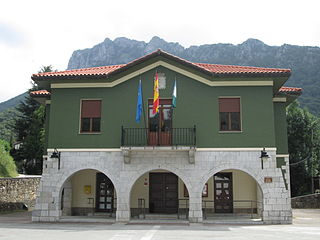
Caso is a municipality in the Spanish Principality of Asturias. It shares a boundary to the North with Piloña; to the East with Ponga; to the South with León and to the West with Sobrescobio and Laviana.
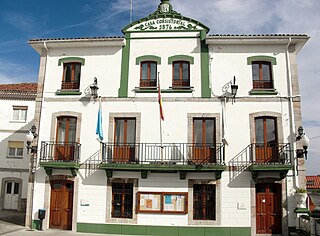
Muros de Nalón is a small coastal municipality in the Spanish province of Asturias, with an area of 8.09 square kilometers. It is bounded to the north by the Bay of Biscay, to the east by the river Nalón, to the south by Pravia and the west by Cudillero. The eucalyptus tree is the town tree and occupies great parts of the slopes down to the coast.

Pre-Romanesque architecture in Asturias is framed between the years 711 and 910, the period of the creation and expansion of the kingdom of Asturias.

Allande is a municipality in the Autonomous Community of the Principality of Asturias, Spain. Its capital is Pola de Allande.

Carreño is a municipality in the autonomous community of the Principality of Asturias, Spain. It is bordered by Corvera de Asturias on the west, Gozón on the north, the Cantabrian Sea on the north and east, and Gijón on the east and south. Its capital is Candás.

Cabranes is a municipality in the Autonomous Community of the Principality of Asturias. Some Towns of cabranes are: Santolaya, Torazu, Fresnéu, Graméu, Pandenes, Viñón, Niao, Arboleya, etc. It is bordered on the north by Villaviciosa, on the south by Piloña and Nava, on the east by Piloña and Villaviciosa and on the west by Villaviciosa y Nava.
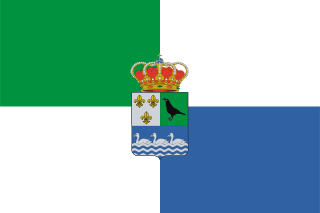
Colunga is a municipality in the Autonomous community of the Principality of Asturias, Spain. It lies on the Cantabrian Sea, and is bordered to the west by Villaviciosa, to the south by Parres and Piloña, and to the east by Caravia.
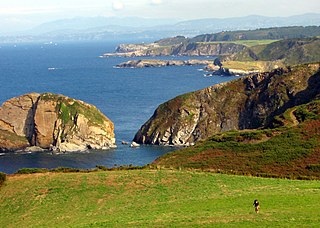
Gozón is a municipality in the Autonomous Community of the Principality of Asturias, Spain. Its capital is the town of Luanco. The Cantabrian Sea lies on its northern edge, and it is bordered to the south by Corvera de Asturias, to the west by Avilés, and to the east by Carreño.
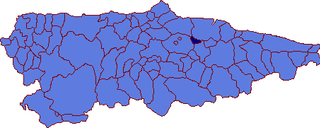
Sariego is a municipality in the Autonomous Community of the Principality of Asturias, Spain. It is bordered on the north by Gijón and Villaviciosa, on the east by Villaviciosa, Nava and Cabranes, on the south by Siero and Nava, and on the west by Siero. The source of the Nora River is within the municipality.

Sobrescobio is a municipality in the Autonomous Community of the Principality of Asturias, Spain. It is bordered on the north by Piloña, on the east by Caso, on the south by Aller, and on the west by Laviana. It is situated in the southeast section of Asturias, at the eastern limit of the Nalón mineral basin.

The church of St Mary at Mount Naranco is a pre-Romanesque Asturian building on the slope of Mount Naranco situated 3 kilometres (1.9 mi) from Oviedo, northern Spain. Ramiro I of Asturias ordered it to be built as a royal palace, part of a larger complex that also incorporated the nearby church of San Miguel de Lillo, 100 meters away. The palace was completed in 842 and had in part a religious function, being consecrated in 848. Its structural features, such as the barrel vault—with transverse ribs corresponding one-to-one with contraforts at the exterior, make it a clear precursor of the Romanesque construction. The exterior decorations, as well as the use of stilted arches mark the intended verticality of the composition.

St. Michael of Lillo is a Roman Catholic church built on the Naranco mount, near the Church of Santa María del Naranco in Asturias. It was completed in 842 and it was consecrated by Ramiro I of Asturias and his wife Paterna in the year 848. It was originally dedicated to St. Mary until this worship passed to the nearby palace in the 12th century, leaving this church dedicated to Saint Michael. It has been a UNESCO World Heritage Site since 1985.
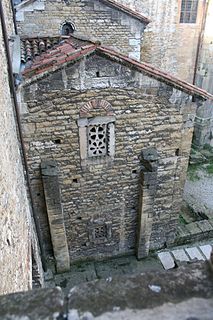
The Holy chamber of Oviedo is a Roman Catholic pre-Romanesque church in Oviedo, Spain, built next to pre-romanesque Tower of San Miguel of the city's cathedral. Nowadays, the church occupies the angle between the south arm of the cathedral transept and a side of the cloister.




























